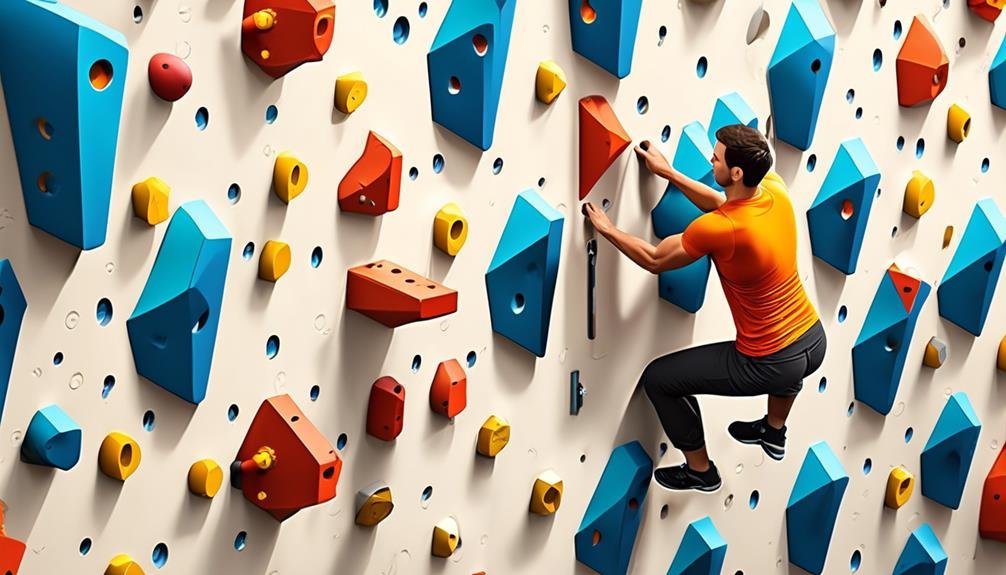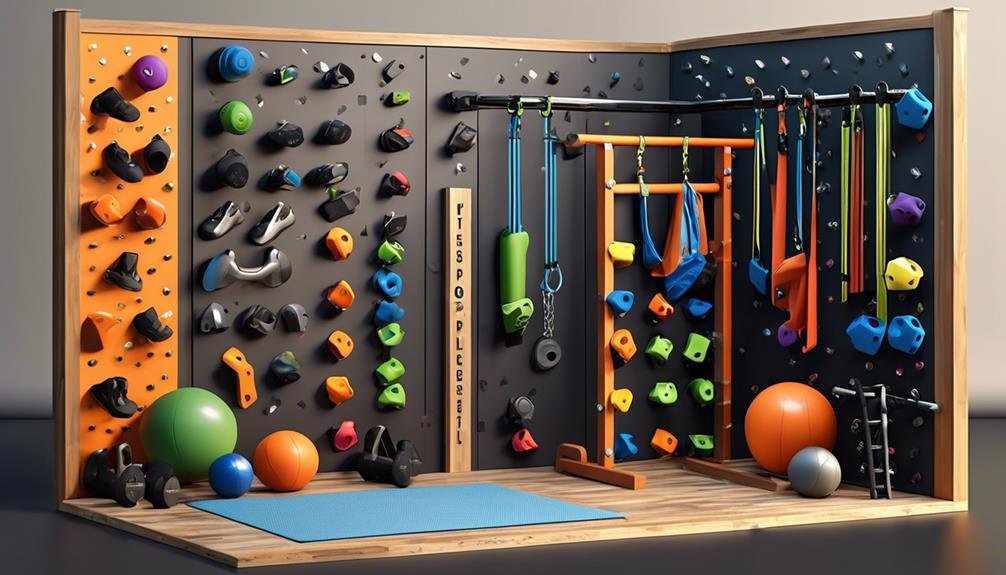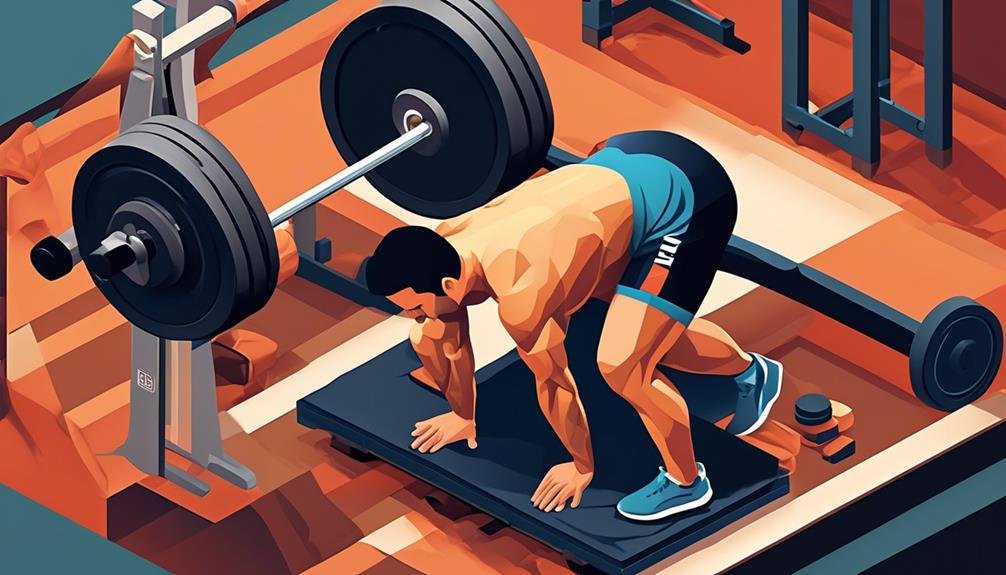Did you know that the global climbing industry is projected to reach a value of $4.3 billion by 2027?
With the increasing popularity of climbing, more and more people are looking for ways to bring the thrill and fitness benefits of this sport into their own homes. That's where climbing holds come in.
In this discussion, we will explore what climbing holds are and how they can be used in home gyms to enhance your workouts and challenge your climbing skills.
So, whether you're a seasoned climber or a beginner looking for a new way to stay active, keep reading to discover the exciting world of climbing holds and how they can elevate your home gym experience.
Key Takeaways
- Climbing holds can improve upper body strength, cardiovascular fitness, grip strength, balance, coordination, and overall body control.
- There are different types of climbing holds, including jugs, crimps, slopers, pinches, and pockets, each challenging different aspects of climbing.
- Installing climbing holds in a home gym requires determining placement, choosing the right hardware, preparing the wall surface, securely attaching the holds, and testing for stability.
- Safety considerations for using climbing holds at home include checking for damage or wear, ensuring proper installation and fastening, using fall protection measures, warming up and stretching, and starting with easy routes to build strength and confidence.
Benefits of Climbing Holds
When incorporating climbing holds into your home gym, you'll experience a multitude of benefits.
Firstly, climbing holds provide an excellent way to improve your upper body strength. By gripping onto the holds and pulling yourself up, you engage your arms, shoulders, and back muscles, helping to build muscle and increase overall strength.
Additionally, climbing holds also offer a great cardiovascular workout. As you climb and move from one hold to another, your heart rate increases, helping to improve your cardiovascular endurance and burn calories.
Another benefit of using climbing holds in your home gym is the improvement of your grip strength. Climbing holds require you to maintain a firm grip, which helps to strengthen your hands and fingers. This can be especially beneficial in activities such as rock climbing, where a strong grip is essential.
Furthermore, incorporating climbing holds into your home gym can also help improve your balance and coordination. As you navigate different holds and move your body weight, you challenge your proprioception and enhance your overall body control. This can have positive effects on your performance in various physical activities.
Types of Climbing Holds
There are various types of climbing holds that can be used in home gyms to enhance your climbing experience and improve your overall fitness. These holds are designed to mimic the natural features found on a rock face, allowing you to practice your climbing skills in a controlled environment.
Here are some of the most common types of climbing holds:
- Jugs: These holds are large and easy to grip, making them perfect for beginners or for warming up. They provide a secure and comfortable grip, allowing you to focus on your technique.
- Crimps: Crimps are small, narrow holds that require precise finger strength and control. They challenge your grip and finger strength, helping you develop better finger dexterity and grip strength.
- Slopers: Slopers are rounded holds with no defined edges. They require a combination of grip strength and body tension to stay on. Working on slopers can improve your body awareness, balance, and core strength.
- Pinches: Pinches are holds that require you to squeeze them between your thumb and fingers. They target your forearm muscles and help improve your pinch strength.
- Pockets: Pockets are small, concave holds that require you to dig your fingers into them. They challenge your finger strength and require precise finger placement.
Installation and Setup of Climbing Holds

To properly install and set up climbing holds in your home gym, it's essential to follow these steps for a safe and effective climbing experience:
- Determine the placement: Assess the space in your home gym and decide where you want to install the climbing holds. Consider factors such as wall height, available wall space, and safety precautions.
- Choose the right hardware: Select the appropriate bolts, screws, and anchors based on the type of climbing holds you have and the material of your wall. Make sure the hardware is strong and secure enough to support your weight.
- Prepare the wall: Clean the wall surface and make sure it's smooth and free from any debris or loose paint. If necessary, apply a primer or paint to improve adhesion.
- Drill and attach the holds: Use a power drill and the chosen hardware to attach the climbing holds to the wall. Ensure that the holds are properly aligned and securely fastened.
- Test the holds: Before climbing, give the holds a thorough inspection to ensure they're stable and secure. Test their stability by applying pressure and pulling on them gently.
Following these steps will help you set up your climbing holds correctly, ensuring a safe and enjoyable climbing experience in your home gym.
Safety Considerations for Using Climbing Holds at Home
For a safe and enjoyable climbing experience in your home gym, it's crucial to prioritize safety considerations when using climbing holds. Here are some important safety tips to keep in mind:
- Check the holds: Before each climbing session, thoroughly inspect the climbing holds for any signs of damage or wear. Look for cracks, loose bolts, or sharp edges. If you notice any issues, replace or repair the holds immediately.
- Proper installation: Ensure that the holds are securely fastened to the wall or climbing structure. Follow the manufacturer's instructions for installation and use appropriate tools and hardware. Double-check the holds regularly to make sure they remain secure.
- Consider fall protection: Depending on the height of your climbing wall and your skill level, it may be necessary to use crash pads or install a safety mat beneath the climbing area. This will help cushion a potential fall and reduce the risk of injury.
- Warm-up and stretching: Before starting your climbing session, warm up your muscles and perform stretching exercises. This will help prevent muscle strains and injuries during your climb.
- Start with easy routes: If you're new to climbing or trying out a new hold, start with easy routes to build strength and confidence. Gradually increase the difficulty level as you progress.
Different Exercises and Workouts With Climbing Holds

Now that you have prioritized safety considerations for using climbing holds in your home gym, let's explore various exercises and workouts that you can incorporate with these holds.
Here are five exercises and workouts that you can try with climbing holds:
- Hangboard Training: Hangboards are climbing holds specifically designed to improve finger and grip strength. Hang onto different holds for a set amount of time to challenge your grip and build endurance.
- Campus Board Workouts: A campus board is a vertical board with climbing rungs. This exercise involves explosive movements, such as skipping rungs or reaching for higher rungs, to develop upper body power and coordination.
- Climbing Wall Traverse: Set up climbing holds on a wall and traverse from one side to the other. This exercise works on your endurance, grip strength, and balance.
- Pull-ups and Chin-ups: Attach climbing holds to a pull-up bar and perform pull-ups and chin-ups. This exercise targets your upper body muscles, including your back, shoulders, and arms.
- Climbing Ladder: Arrange climbing holds in a ladder-like pattern on a wall. Climb up the ladder using different holds and hand placements to challenge your climbing skills and improve your technique.
Incorporating these exercises and workouts into your climbing routine will help you improve your climbing abilities and overall fitness. Remember to start with easier holds and progress gradually as you build strength and confidence.
Tips for Maximizing Your Home Gym With Climbing Holds
Maximize your home gym with climbing holds by implementing these effective tips.
First, consider the layout of your gym and strategically place climbing holds on various surfaces. This will allow for more diverse and challenging workouts. You can attach holds to walls, beams, or even create a climbing wall using plywood.
Next, make sure to have a variety of hold types. Different holds offer different grips and challenges, such as crimps, slopers, and jugs. This will provide a more comprehensive and well-rounded workout.
Additionally, don't forget to regularly change the positions and configurations of the holds. This will keep your workouts fresh and prevent plateauing.
Furthermore, consider incorporating other gym equipment, such as resistance bands or TRX straps, with your climbing holds. This will add variety and intensity to your workouts.
Lastly, always prioritize safety. Ensure that the holds are securely attached and regularly inspect them for any signs of wear or damage.
With these tips, you can effectively maximize your home gym with climbing holds and achieve a challenging and enjoyable workout experience.
Frequently Asked Questions
Are Climbing Holds Suitable for Beginners?
Yes, climbing holds are suitable for beginners. They provide a safe and controlled environment for learning climbing techniques. With proper instruction and practice, beginners can develop strength, coordination, and confidence on climbing holds.
How Do I Determine the Appropriate Size and Quantity of Climbing Holds for My Home Gym?
To determine the appropriate size and quantity of climbing holds for your home gym, consider your skill level, available space, and desired difficulty. Start with a variety of holds to challenge yourself and gradually add more as you progress.
Can Climbing Holds Be Used on Outdoor Walls?
Yes, climbing holds can be used on outdoor walls. They provide hand and foot placements for climbers and can be attached securely to various surfaces, allowing for a challenging and fun outdoor climbing experience.
Are Climbing Holds Compatible With Different Wall Materials, Such as Concrete or Wood?
Climbing holds can be used on different wall materials like concrete or wood. They are compatible and provide a challenging climbing experience in home gyms.
How Often Should Climbing Holds Be Inspected for Wear and Tear?
You should inspect climbing holds for wear and tear regularly to ensure safety. Check for any cracks, chips, or loose bolts. Replace any damaged holds immediately and follow the manufacturer's recommendations for maintenance.
Conclusion
In conclusion, climbing holds are a valuable addition to home gyms as they provide numerous benefits. These benefits include improved strength, flexibility, and coordination.
There are various types of holds available, and their installation and setup are relatively simple. However, it's crucial to prioritize safety when using climbing holds at home and to follow proper guidelines.
Incorporating different exercises and workouts with climbing holds can help maximize your home gym experience and enhance your overall fitness level.





